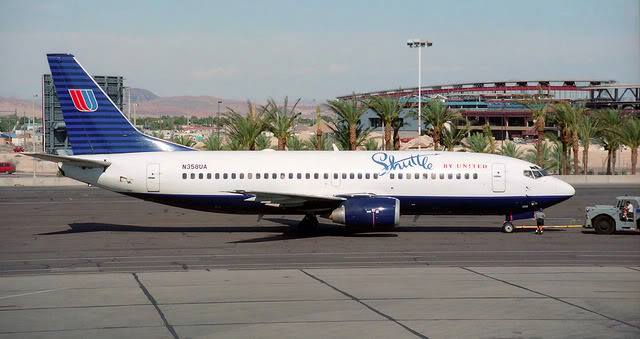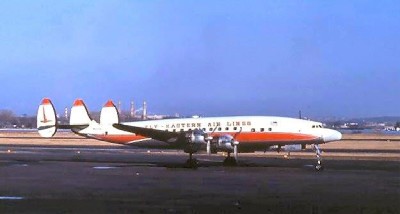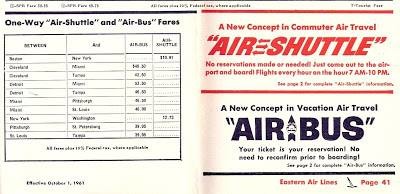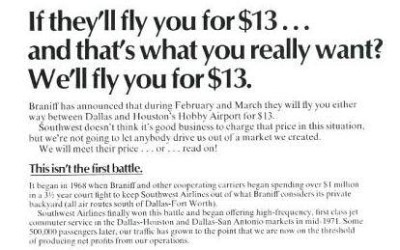
Note: This is part 1 of this history on airline shuttles. You can find part 2 here.
Being a desert dweller in the southwest, I’ve become quite used to being able to go from A to B with a minimum of fuss – for the most part, I commute to Los Angeles, Las Vegas & San Francisco on a plethora of daily flights. In some cases, my carrier of choice (Southwest) has almost hourly service between these cities, making it easy & fast for me to choose a flight and go when I need to.
But what is the origin of this frequent service? And for that matter, how does it all fit into the grand scheme of the Air Shuttles? Let’s take a trip back to the 1920s to the present at the real roots of the Air Shuttle as we know it.
Back in the late 1920s, airlines were in their infancy, and heavily dependent upon subsidies from the US Postal service. Very few routes could be justified as anything other than experimental flights, and passengers carried as gravy on the postal rate mail. Western Air Express (The forerunner of Western Air Lines) came up with a concept known as the Model Airway – a route between San Francisco & Los Angeles that would be flown several times a day each way using the most modern systems possible for a reliable, safe & convenient service. The three hour trips started off once a day, and included lunch on-board served by Western’s own stewards. In 1931 the air mail scandal ended this prototype service – but only for a short while.

1946 brought a boom to air travel, as surplus military planes were available to the airlines cheaply. This, combined with a growth in income meant more people could fly than before. Eastern Air Lines saw this as a huge opportunity to fly people from A to B with the minimum of service – and at the lowest cost possible. However, the Civil Aeronautics Board found issue with this initial idea of ‘coach’ as a concept, and turned down Eastern’s initial application to fly frequent, low-cost service in between key city pairs.
The idea would have to wait. At the same time, in California a small rag-tag airline outfit in San Diego that was not regulated by the C.A.B. Providing a regular, low-cost & high frequency service, PSA began flying between San Diego, Burbank & Oakland – with immediate success. Tickets were intentionally lower in price, service was at a bare minimum, and passengers FLOCKED to the fledgling airline.
The major trunk carriers took notice – and more airlines began to ask the C.A.B. to start their own services. The protectionist instincts of the C.A.B. limited these airlines – but Eastern was not going to give up.
Air Bus?

By the late 1950’s, jet transport was beginning to surpass the early prop-liners at an astounding pace. The introduction of jets left many airlines with a glut of new yet outdated prop transports. Eastern saw an opportunity to make the best use of their prop fleet by removing their original first class interiors and installing as many seats as safety would allow. Meals would be eliminated – or charged for – and everything on these flights would be basic. Using route authorities that were dormant, Eastern started their experimental Air Bus service, promising lower than bus & rail fares to popular cities in Florida.
Lockheed Constellations outfitted with 125 tourist seats flew full of happy, cost-saving tourists from the upper midwest to Florida three or four times a day on the Air Bus. At the time, Floyd Hall & Col. Rickenbacker could see a real opportunity to do this same service – but in a much larger market. Again applying to the C.A.B., Eastern wanted to fly a no-reservation service between Boston, Newark, New York/LaGuardia and Washington/National on an hourly basis. Service would be bare-bones, with only coffee and water offered. Ticketing would be done by hostesses on the plane in flight, and if the flight was full, an additional plane was rolled out – even if for just one person. On 30 April 1961, the Eastern Air Shuttle was born – and was an immediate unqualified success. Passengers flocked to the service, and the profits rolled in. So successful was the Air Shuttle that it formed nearly 50% of Eastern’s profits during lean years; considering that Eastern was the free-world’s largest airline it is quite a statement.
Spreading LUV all over Texas

Meanwhile, a lawyer, a banker & an investor walk into a gentleman’s club in Texas. After much drinking, the three decided to start an airline. After five years of legal battles, Southwest Airlines took to the skies in 1971, offering frequent, low-cost service between three Texas cities. By utilizing the smaller (and less congested) city airports in Dallas & Houston, they were able to operate more flights more frequently, and charged 1/2 the fare of the major trunk carriers. So big was this war that in 1973, the incumbent carriers chopped their fares on these routes to $13.00 – or 1/2 of the base Southwest fare.
To compete (and to survive) Southwest offered a deal: Pay the $26.00 fare, and we’ll give you a fifth of liquor, or we’ll match their $13.00 fare. For two months in 1973, Southwest Airlines was the largest distributor of Chivas Regal, Smirnoff & Crown Royal in all of Texas. In the end, Braniff & the others pulled back, Southwest won the battle – and survived. In the end though it was their recipe of high-frequency flights at low fares that pushed the idea of shuttle service to a whole new level. By stimulating traffic with lower fares, a whole new market of customers was born.
Tune in tomorrow for part 2 where I’ll discuss deregulation, Donald Trump and look at the future of shuttles.
Note: This is part 1 of this history on airline shuttles. You can find part 2 here.



[…] new American Airlines, the History of Low Cost Carriers, United Airlines, the History of Air Shuttles, The Middle East 3, Alaska’s purchase of Virgin America, United’s […]
[…] rise of Delta, the new American Airlines, the History of Low Cost Carriers, United Airlines, the History of Air Shuttles and The Middle East 3. He has been involved with the airline industry for over 20 years and is an […]
[…] Shuttle Diplomacy: The Rise of American Aviation’s Backbone […]
Not the typical boarding area post but very interesting. Was a great read.
Glad you liked it! Part 2 will be published tomorrow.
Thanks! Not everything I write is op-ed, though part II does contain some of my crystal ball predictions for the future of the shuttles.